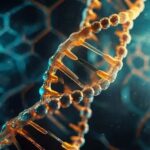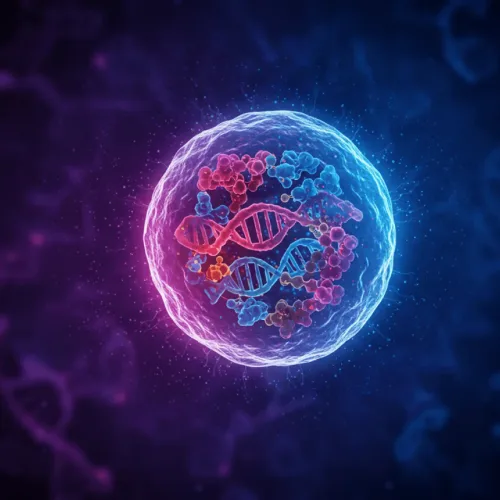DNA replication is a fine process as far as biology is concerned. It is simple yet so efficient. You can not really picture anything better. Over single handed responsibility for passing the genetic information to the next generation. How does this intricate process occur? Specialized enzymes are responsible for the answer. But these biological catalysts keep copies of DNA with such precision and at such speed. This important one would be fraught with errors without enzymes, threatening the lives of all living organisms.
Enzymes are highly skilled factory workers, each of whom performs just one job so that DNA replication goes smoothly. The molecular machines depicted in these images unwind double helices, document uncoiling, and seal the final strands. In this blog, we will know more about what these enzymes do. It will demonstrate how it keeps the genetic blueprint that marks any living being.
What Is DNA Replication?
DNA replication is the biological process in which DNA (a major constituent of chromosomes) copies itself from one strand into two identical strands. The cell splits before this takes place. It makes the daughter cell exactly like the parental body with its genetic code. This is an incredibly precise process. A little mistake can mutate a cell. It might destroy a cellular function or make you sick.
DNA replication unfolds in three essential steps:
- Initiation: The double stranded DNA unwinds and now exposes its two strands. It is a replication fork, where new strands will be built.
- Elongation: Enzymes start with a new strand that begins with nucleotides that are the same except for the right and left that will be complementary to the original strands. There can be high accuracy in this step.
- Termination: At the end, the two strands are synthesized by enzymes until they become identical to every other copy of it, hence double stranded.
The unique property of DNA replication is that it happens in a semiconservative manner. The molecules are 1 new, which is one newly synthesized strand joined with 1 old, one original strand. This design provides error reduction and has the added advantage of genetic stability from one generation to the next.
Important Enzymes for DNA replication

Enzymes are responsible for ensuring that every step in DNA replication runs smoothly. Here we will take a closer look at the main enzymes that are involved and their specific roles.
1. Helicase
DNA replication involves in separating two DNA strands in the first step. Helicase is the enzyme that is responsible for this process. It moves along the DNA and “unzips” the helix by breaking the hydrogen bonds between the bases. This process opens up the DNA and creates two single strands ready for replication.
2. Primase
Now those strands have separated, they need something to help to boost the replication process. Primase is an enzyme that forms a small RNA primer, which provides a starting point for DNA synthesis. This primer is essential because DNA polymerase cannot start the process on its own.
3. DNA Polymerase
The real action is connected with DNA polymerase. This enzyme binds the RNA primer and starts adding new nucleotides to the existing strand. DNA polymerase works like a builder, in ensuring that the new DNA strand matches perfectly with the original design. It checks each nucleotide for errors and corrects them, which is important to prevent mutations.
4. Ligase
After that the DNA polymerase finishes synthesizing the new strands, small gaps remain between the fragments. DNA ligase then take action to seal these gaps by joining the fragments together. Without this crucial action from ligase, the new DNA would stay incomplete, and the replication process would fail to finalize.
The Role of Single Strand Binding Proteins
Not only enzymes, single strand binding proteins (SSBs) also play a supporting role in DNA replication. After opening the helicase DNA, SSBs bind them to a single strand and prevent them from snapping back together. They stabilize the strands, to ensure that they remain open and accessible to other enzymes.
Accuracy in DNA Replication Process
The accuracy of DNA replication is very significant for life. Without the accuracy provided by enzymes, genetic information will quickly break down, leading to harmful mutational effects. DNA polymerase acts as a scanning tool, adjust any mistake that occur during nucleotide addition. This enzyme can also remove the wrong nucleotides and replace them with the right ones, ensuring that the new strand is almost identical to the original.
Moreover, enzymes such as helicase and ligase assure that the replication process proceeds smoothly without any interference. They prevent meshes in the DNA and ensure that the entire strand is replicated without interruption. This level of coordination between enzymes is stunning and shows the importance of these small molecular machines.
The Leading and Lagging Strands
The two strands of DNA run in opposite directions, so, unfortunately, DNA replication isn’t as straightforward as it would seem. Due to this difference, leading and lagging strands cannot be synthesized easily.
Leading Strand
DNA polymerase builds the leading strand by putting nucleotides in place. It does this in the same direction as the replication fork moves. Helicase opens up the DNA. This lets the polymerase work without stopping to make the strand.
Lagging Strand
One of the main problems is the direction the lagging strand runs. Okazaki fragments are products of DNA polymerase, which can only add nucleotides in short bursts. The necessary work these fragments need to do to become a complete strand is done by primase, DNA polymerase, and ligase, respectively.
The coordination of this effort is proof positive that enzyme activity in DNA replication is precise and complex.
Enzymes Beyond Replication
Not only do DNA replication enzymes copy DNA, they also do a lot more. They participate in several other crucial cellular processes, including:
- DNA Repair: In normal circumstances, the engines of DNA repair are DNA polymerase and ligase. DNA is injured. These remain consistent. This kind of DNA injury is caused by external factors like UV radiation or chemicals. It also helps protect cells from damage and from genomic instability.
- Recombination: Helicase and ligase in homologous recombination are enzymes that facilitate the occurrence of meiosis. These enzymes make sure that identical … from the genetic chain of chromosomes is exchanged.
- Gene Expression Regulation: Indirectly, certain replication-related enzymes determine which genes within a cell are active or inactive.
Further, these additions of roles broaden the versatility of these replication enzymes. Without them, cellular health and life processes would essentially cease to exist.

Importance of Enzymes in Biotechnology and Medicine
DNA replisome enzymes have completely revolutionized biotechnology and medicine. Their ability to manipulate and copy DNA has opened doors to groundbreaking applications:
- Polymerase Chain Reaction (PCR): One area of DNA technology uses DNA polymerase to amplify target DNA sequences. This amplification is for examination by forensic, genetic diagnosis, or medical treatment. PCR is an indispensable tool in current research in molecular biology.
- Gene Editing: To be actually copied out exactly, techniques like CRISPR can do that. The possibility is made possible by enzymes such as DNA polymerase and ligase. The results of this research are believed to address some genetic diseases.
- Cancer Therapy: Currently, drugs targeting replication enzymes are being developed that interfere with cancer cells’ rapid replication. As a matter of example, topoisomerase inhibitors delay the progress of tumors by impeding DNA replication in crazy cells.
These applications illustrate how understanding replication enzymes contributes to scientific innovation and improves human health.
Conclusion
That is where unsung heroes of DNA replication step in: enzymes, which orchestrate a process that is critical to life. Every enzyme that does something to make DNA copied accurately and efficiently duplicates works one precise job. These enzymes do more than replicate: they shield cells from genetic damage, and they open doors to medicine and biotechnology.
DNA replication enzymes continue to undergo study with new insights for use in cancer therapy, genetic engineering, and disease prevention. At the same time, we are finding out more about what these molecular machines can accomplish. They are still essential to understanding how life works. They also tell us how to keep it or how to make it disappear.




